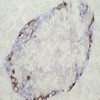Effects of Fungal Pancreatic Enzymes on the Function of Islet Cells in Syrian Golden Hamsters
Abstract
Context Our previous studies showed that porcine pancreatic enzymes in Syrian golden hamsters with peripheral insulin resistance normalizes the plasma insulin level, reduces the size of enlarged islets and inhibits the increased DNA synthesis in the beta-cell of islets. Objective In order to exclude the possibility that these effects was attributed to some contaminants of this crude material, we tested the effect of purified fungal pancreatic enzyme (FPE) that contains primarily amylase and lipase without (FPE) and with addition of chymotrypsin (FPE+chy). Material and methods In a pilot study we tested the effect of different doses of FPE given in drinking water on insulin level, islet size and DNA synthesis of islet cells in hamsters with induced peripheral insulin resistance by a high fat diet. The most effective dose of FPE on these parameters was used in a long-term experiment with FPE and FPE+chy in hamsters fed a high-fat diet for 36 or 40 weeks. Results In the pilot study a dose of 2 g/kg body weight was found to be optimal for controlling the body weight, normalizing plasma insulin level, the size of islets, the DNA synthesis and the number of insulin cells in the islets. These data were produced in the long-term study, where steatorrhea was also inhibited. Addition of chymotrypsin had no effects on these parameters. Conclusion Pancreatic lipase and amylase appear to be responsible for the observed effects and offer a safe and effective natural product for the treatment of pancreatic diseases, including acute pancreatitis, chronic pancreatic, cystic fibrosis and any conditions associated with peripheral insulin resistance, including obesity and type 2 diabetes. The possible mechanism of the action is discussed.
Image: In the fungal pancreatic enzyme-treated group, 25% of the cells react with anti-glucagon (blue) and 10% with anti-somatostatin antibody (brown).
Downloads
References
Saruc, M, Nozaw F, Yalniz M, Itami, A , Pour PM. Effects of porcine pancreatic enzymes on the pancreases of hamsters. Part 1. Basic studies. JOP 2012 (in press).
Nozawa F, Yalniz M, Saruc M, Standop J, Egami H, Pour PM. Effects of porcine pancreatic enzymes on the pancreas of hamsters. Part 2. Carcinogenesis studies. JOP 2012 (in press).
Birt DF, Pour PM: Increased tumorigenesis induced by N-nitrosobis(2-oxopropyl)amine in Syrian golden hamsters fed high-fat diets. J Natl Cancer Inst 1983;70:1135-1138.
Birt DF, Julius AD, White LT, Pour PM: Enhancement of pancreatic carcinogenesis in hamsters fed a high-fat diet ad libitum and at a controlled calorie intake. Cancer Res 1989;49:5848-5851.
Ding XZ, Fehsenfeld DM, Murphy LO, Permert J, Adrian TE. Physiological concentrations of insulin augment pancreatic cancer cell proliferation and glucose utilization by activating MAP kinase, PI3 kinase and enhancing GLUT-1 expression. Pancreas 2000;21(3):310-20.
Hsu SM, Raine L, Fanger H: Use of avidin-biotin-peroxidase complex (ABC) in immunoperoxidase techniques: a comparison between ABC and unlabeled antibody (PAP) procedures. J Histochem Cytochem 1981;29:577-580.
Pour PM, Kazakoff K, Dulany K: A new technique for simultaneous demonstration of 4 tumor-associated antigens in pancreatic cancer cells. Zentralbl Pathol 1994;140:397-401.
Pour PM, Duckworth W, Carlson K, Kazakoff K. Insulin therapy prevents spontaneous recovery from streptozotocin-induced diabetes in Syrian hamsters. An autoradiographic and immunohistochemical study. Virchows Arch A Pathol Anat Histopathol 1990;417(4):333-41.
Drummey, G.D., J.A.J. Benson, and J. C.M., Microscopical examination of the stool for steatorrhea. N Engl J Med, 1961. 264: p. 823-835.
Fine, K.D. and F. Ogunji, A new method of quantitative fecal fat microscopy and its correlation with chemically measured fecal fat output. Am J Clin Pathol, 2000. 113(4): p. 528-34.
Gravene C, Mathias PC, Ashcroft SJ. Acute effects of fatty acids on insulin secretion from rat and human islets of Langerhans. J Endocrinol 2002; 173:73-80.
Kiens B. Skeletal muscle lipid metabolism in excersise and insulin resistance. Physiol Rev. 2006; 86:205-243.
Warnotte C, Gilon P, Nenquin M, Henquin JC Mechanisms of the stimulation of insulin release by saturated fatty acids. A study of palmitate effects in mouse beta-cells. Diabetes 1994,43, 703-711.
Bogden G. Role of fatty acids in pathogenesis of insulin resistance and NIDDM. Diabetes 1997; 46:3-10.
Kraegen EW, Cooney GJ, Ye JM et al. The role of lipids in the pathogenesis of muscle insulin resistance and beta cell failure in type II diabetes and obesity. Exp Clin Endocrinol Diabetes 2001;109:Suppl 2:S189-201.
Frost SC, Clark WA, Wells MA. Studies on fat digestion, absorption, and transport in the suckling rat. IV. In vivo rates of triacylglycerol secretion by intestine and liver. J Lipid Res, 1983, 24:899-903.
Jesper Gromada The Free Fatty Acid Receptor GPR40 Generates Excitement in Pancreatic ß-Cells Endocrinology 2006: 47:672-673.
Itoh Y, Kawamata Y, Harada M et al. Free fatty acids regulate insulin secretion from pancreatic ß cells through GPR40. Nature 2003; 422:173-176.

Copyright (c) 2014 Fumiaki Nozawa, Mehmet Yalniz, Murat Saruc, Jens Standop, Hiroshi Egami, Parviz M Pour

This work is licensed under a Creative Commons Attribution 4.0 International License.
As a member of Publisher International Linking Association, PILA, iMedPub Group’s JOP follows the Creative Commons Attribution License and Scholars Open Access publishing policies. Journal of the Pancreas is the Council Contributor Member of Council of Science Editors (CSE) and following the CSE slogan Education, Ethics, and Evidence for Editors.